Modifying Application Configurations with the ASC
| | ||
| | ||
| | ||
Within the ASC, changes for the application can be made to the default application settings and also to the individual application. In this section, you'll see where changes can be made at both levels.
Default Application Settings
When an application is deployed, it takes default settings unless those are overridden. These settings are set at the OC4J instance level. They settings are composed of the following four categories:
-
Data Sources
-
Security
-
Java Message Service (JMS) Providers
-
Global Web Module
Links to these settings are found under the OC4J instance administration page under Application Defaults. They're shown in Figure 18-14.
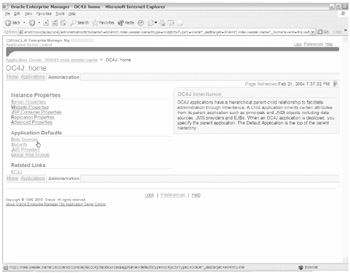
Figure 18-14: Application Defaults section
Modifying these settings from this page will change the default settings for the OC4J instance. However, most applications are deployed with the specific settings they need specified within the EAR file, so administrators generally do not make frequent changes at this level although we'll show you how to do it.
Application-Specific Settings
Multiple applications can be deployed to a single OC4J instance. They can have different settings, and can be deployed, redeployed, or undeployed individually. These are managed via the OC4J instance Deployed Applications page, as shown in Figure 18-15.
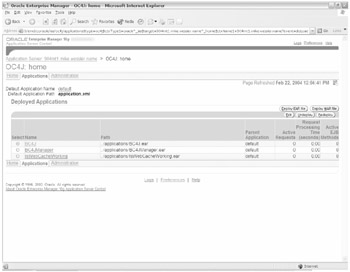
Figure 18-15: Deployed Applications page
In Figure 18-15, you can see that three applications are deployed by default to the OC4J home instance. They are BC4J, BC4JManager , and IsWebCacheWorking . In addition to buttons that will individually deploy, redeploy, or undeploy each application, there are options to deploy new EAR or WAR files. Statistics for the number of active requests , the processing time, and the active EJB methods are also listed.
For more detailed information and control for any application, click the application name or select it with the radio button on the left and click the Edit button.
In Figure 18-16, you can see the page for the BC4J application. It's composed of four sections: General, Web Modules, EJB Modules, and Administration.
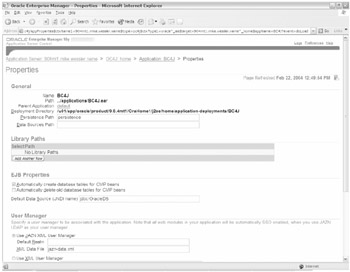
Figure 18-16: Application BC4J page
In the General section you can see the application is loaded into memory by default because Auto Start is set to true . More detailed performance metrics are provided for both Servlets and JSPs and EJBs. Buttons to redeploy or undeploy the application are available.
The Web Modules section shows which JSPs or Servlets compose the application. In this case you see that cabo and webapp are present with their identifying WAR files (remember EAR files contain WAR files), followed by the number of active requests. Clicking a module name such as webapp will display even more detailed information regarding response time and load in terms of number of active sessions and requests per second.
The EJB Modules section shows if any EJBs are loaded and if they're active. In this case, there are no EJBs loaded.
The Administration section is for the individual application and is composed of the following three subheadings with clickable links:
-
Properties: General and Advanced Properties
-
Resources: Data Sources and JMS Providers
-
Security: Security
You can change your application specific settings by clicking Preferences under these headings.
Properties
The General section shows general properties for the application, options for special library paths, EJB properties, the JAZN User Manager (same as the last deployment page), and options for initialization parameters, as you can see in Figure 18-17.
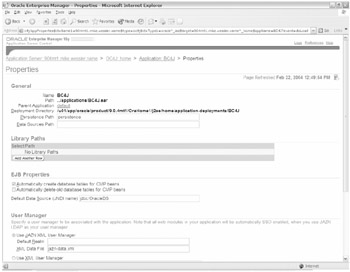
Figure 18-17: Properties page
The Advanced Properties page provides links to manually update the orion-application.xml and principles.xml files.
Resources
The Data Sources page provides access to data sources defined in data-sources.xml . The JMS Providers page allows for the configuration of JMS sources.
Security
The Security page allows for the setup of principles and security roles, as shown in Figure 18-18.
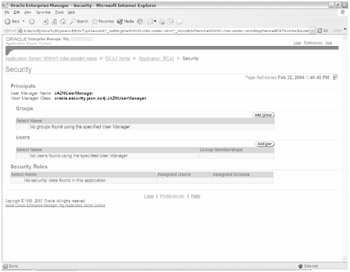
Figure 18-18: Security page
In this section you learned about some of the pages that you could use to change application settings after the deployment. Oftentimes the settings will be within the EAR file as they're provided to the deployer, but these pages allow you to change some settings.
| | ||
| | ||
| | ||
EAN: 2147483647
Pages: 150